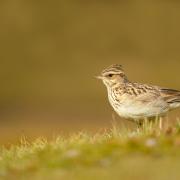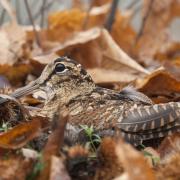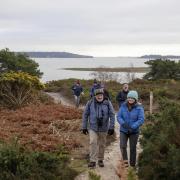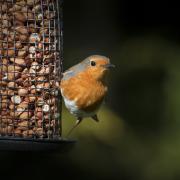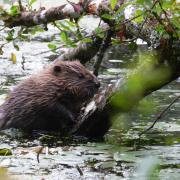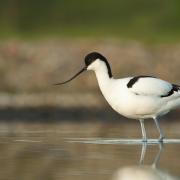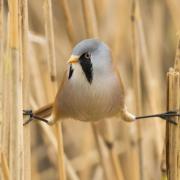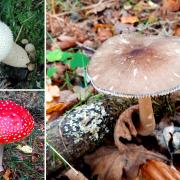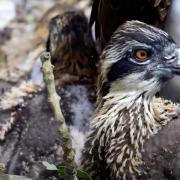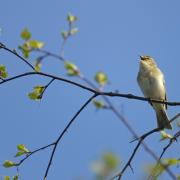The RSPB is involved in a lot more than saving birds. Emma Foulger meets a couple of people in Dorset who care for some of the other creatures to be found on RSPB reserves
The RSPB is involved in a lot more than saving birds. Emma Foulger meets a couple of people in Dorset who care for some of the other creatures to be found on RSPB reserves
I'm standing at Arne. Ahead of me is a vast swathe of heathland. It's home to a fantastic variety of unusual creatures including nightjars and the silver-studded blue butterfly, and the insect-eating sundew plant. But Arne is also home to sand lizards, which are near the top of the 'rare' list. These are the responsibility of site warden Toby Branston, and the reason I'm here today.
"I remember my first sighting of a sand lizard," Toby comments, as we start to wander across the heath. "Of all places, it was up a tree! Only later did I learn that they are brilliant climbers. They are also experts at digging in the sand to lay their eggs."
As we walk, Toby explains that being able to climb is all about finding insect food and a place to bask in the sun. Being cold-blooded, the warmth of the sun is important in helping them maintain body temperature.
"Another thing that struck me," Toby continued, "was its markings. This was a female with a beautiful patterned back of brown and orange, with olive green. It's great camouflage but not a patch on the males who turn a magnificent emerald green in spring."
Our walk takes us over the heather to some bare ground on a slope. "These areas are important for egg laying," Toby explained, "and last year, with the help of an excavator, we created over 21/2 acres of new bare ground just for our lizards."
In addition, Toby pointed out that visitors to Arne unwittingly help as well. "All our visitors help create permanent areas of bare ground along sides of paths where they walk. These are often the best places for seeking out lizards during the spring."
We walked and talked some more, but sadly, despite our best efforts we couldn't find a lizard. However, something tells me I will be back to find my emerald-green sand lizard.
Emma's doormice
I'm now at Garston Wood, a quiet corner of North Dorset. People have been working here for centuries, cutting hazel and transforming the woodland into a garden of delights full of wild flowers, butterflies and birdsong. It's also a superb place for that cutest of creatures, the dormouse.
I'm with Emma Stephens who runs the RSPB's office at Arne, and who is a dormouse addict! We're here to check the dormouse boxes.
"I started working in the RSPB's office in 2003, but soon realised I needed something to get me from behind the desk," Emma said. "I'd visited Garston Wood, loved it, and jumped at the chance to help with the dormouse project."
Six years on, she's a key part of the RSPB's dormouse conservation work. "It was during coppicing work in the woodland that a dormouse was first discovered. These orange-coloured mice are very distinctive looking, with a short tail."
She explained enthusiastically that hazel is cut in small areas to create a chessboard effect, with recently coppiced hazel next to old. This means the mice always have a larder of food and it also encourages more hazelnuts to grow.
"After winter asleep the dormice wake from the end of March very hungry and munch their way through catkins, buds and flowers," Emma tells me. "In June and July they have young and need a protein-rich diet of insects to cope with up to eight little ones. By October and November they are beginning to feel cold and fatten up for the winter hibernation on berries, nuts and seeds."
Emma pointed out to me what looked like a bird box low down on a tree trunk. "We have 165 of these dormouse boxes in the woodland. Myself and volunteers check these monthly between April and November."
Dormouse boxes have the entry hole against the tree trunk and a sliding opening so that mice don't get 'squished' when the boxes are checked. These are fixed to trees at head height and used by dormice for breeding. We start to check the boxes, Emma reminding me that special training and a licence is needed to do this.
Eventually, after looking at numerous empty boxes, we find a nest. It's the size of a grapefruit and Emma pointed out the stripped honeysuckle that is woven into a soft ball at the centre.
The results of these checks vary due to changes in the weather, but the sheer number of nests found each time indicates a large population in the wood. Since 2000, the largest number of dormice found in one visit was 29 and the largest number of nests was 36. So, the future looks bright for dormice at Garston Wood, and with people like Emma looking after them, I can see why!
3 May
Showcasing Walks, RSPB Garston Wood Nature Reserve. 10am-4pm
Find out about the wildlife and management of this tranquil reserve on one of the free guided walks, led on the hour by RSPB staff and members of the South Wiltshire Local Group.
To find out more, ring Arne Nature Reserve office
(01929 553360.
30 May
Reptile Ramble family event, RSPB Arne Nature Reserve. 9.30am-1pm
We will look for all six British species of reptiles on this walk, and the Herpetological Conservation Society will also be there with live lizards in tanks, so we can get to know our subjects first. Activities for children.
Members �1, non-members �3, children free. Booking essential on (01929 553360).







